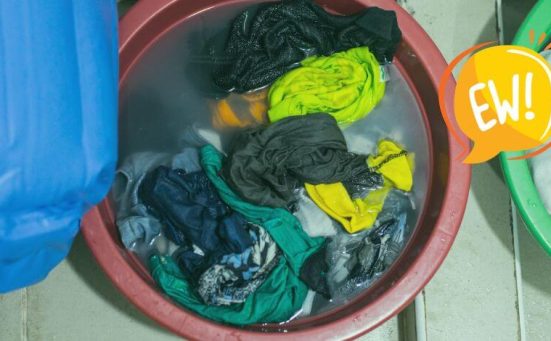
Can You Wash A Duvet In A Washing Machine? (read this first)
We all want to sleep in a comfortable bed with fresh, clean bedding. Not only does it feel good, it’s better for your health. But how often should you wash the duvet and can you wash the duvet in a washing machine? Keep reading as we reveal the answers to those and other duvet related questions.
If You Aren’t Regularly Washing Your Quilt, You’ll Want To Know This…
The average human sheds a terrific amount of skin every day. This is normal and not that well known, what’s also not well known is that most of that skin is shed in bed. The problem with this is that the skin starts to break down and cause mould.
As if this wasn’t bad enough, this particular mould is the food for dust mites. Which means your bed is a breeding ground for dust mites. Dust mite faeces is the biggest cause of allergies in humans, allergies including asthma.
As part of our cleaning process we all change and wash bedding regularly and some of us even clean the mattress regularly. But what about the duvet? Duvets and pillows are often overlooked when it comes to cleaning our bedding, the pillowcases and duvet covers get washed but not the pillows and duvets encased by them.
This is understandable, who wants to lug a heavy duvet all the way to the laundrette, because it won’t fit in the home washing machine right?
It depends on the filling of the duvet, but many can be washed at home in the family washing machine.
How Often Should You Wash The Duvet?

It is recommended that the duvet and pillows should be washed every two months for allergy sufferers and at least twice a year regardless of allergies. This should ensure all of those nasty dust mites are removed and also that the estimated 200ml of sweat that we produce every night is removed too.
Duvet Specific Wash Care
Duvets regardless of size and tog rating come in two types, those with synthetic fillings and those with natural fillings. They need different washing arrangements as can be seen below;
Cleaning Synthetic Filled Duvets
Always check the care label but as a general guide, duvets with synthetic fillings can be washed at 60C (140F) and should be washed at 60C to remove any dust mites etc. Always check that the duvet will comfortably fit into the machine with enough room to allow the fabric to agitate during the washing cycle.
Any size duvets of king size or above, with a tog rating of 13.5 or greater should be washed in a washing machine with a large capacity drum. Most modern machines have large capacity drums so this shouldn’t be too much of a problem.
You’ll probably only need about ⅓ of the detergent you usually use on a regular wash, and only use a standard spin cycle. Once you remove the quilt from the machine you should shake it out to redistribute the filling evenly whilst it’s still damp.
Natural Fillings
There are several natural fillings used in duvets and they all need treating differently.
Cleaning Feather Filled Duvets
Due to the feathers used as filling in some natural filled duvets, it is best to take this to a specialist cleaner. It is possible to wash them at home but most washing machine drums aren’t large enough to facilitate this function properly.
It should also be noted that feather filled duvets will take far longer to dry than synthetic filled duvets and it is essential to completely dry the duvet before returning it to the bed. Even if the duvet fills dry to the touch, it could be the feather filling is not dry which could lead to the filling rotting.
Cleaning Silk Filled Duvets
It is not advisable to wash a silk filled duvet by hand or in a machine unless the care label gives specific instructions. It is best practice to cover a silk filled duvet completely and spot clean it as and when necessary.
Cleaning Wool Filled Duvets
As long as it will fit comfortably into the drum of your washing machine, wool filled duvets can be washed on the wool cycle using the correct detergent for wool and spun at the correct speed for wool.
What Drum Capacity Is Needed To Wash A Duvet?

Below is a general guide for the size drum needed for different size duvets. This is only to be used when care instructions are missing as it doesn’t take into consideration whether the duvet is of a high tog rating or what type of filling it has.
| Duvet Size | Drum Capacity |
|---|---|
| Heavy King-Size | 10kg |
| Medium King-Size | 9kg |
| Queen-Size | 8kg |
| Double | 7kg |
| Single | 6kg |
Can You Dry Clean A Duvet?
Dry cleaning a duvet is not recommended as dry cleaning uses certain chemicals which could damage the filling of the duvet. Specialist cleaners are safe as they use large scale washing machines and wash the duvet in a similar way to how you would wash it at home.
Can You Hand Wash A Duvet?
It is possible to hand wash a duvet and many find this the best solution as it is a gentler way to wash the duvet than using a washing machine. Plus, of course, if your washing machine’s drum is too small, it saves taking the duvet to the launderette.
The Best Way To Hand Wash A Duvet Is In The Bath
To wash a duvet in the bath you should fill the bath around halfway with lukewarm water, add detergent and use your hand to agitate the water to create suds. Then place the duvet in the bath and fully submerge it in water. Let the duvet soak for a few minutes and then using both hands use a kneading motion as if you were kneading dough.
When you feel you’ve passed enough detergent and water through the duvet, empty the bath and refill to the same level with clean lukewarm water. Knead again to begin removing the soap suds from the duvet. This can take some time and involve refilling and emptying the bath numerous times until the water runs clear (with no soap suds). Then remove the duvet from the bath after gently squeezing as much of the excess water from it as possible.
How Often Should A Duvet Be Replaced?
It is recommended that a duvet should be replaced every 5 years or so. But you will be able to tell if it needs replacing sooner because it will either;
- Become Lumpy
This usually happens if the duvet has been washed too many times - Become Thin
This can happen due to too much use, the fillings fail to trap air and will not insulate against the cold anymore - Develops Tears
If the duvet has developed a few tears or rips, the filling will escape which will result in it not insulating against the cold anymore.
When you do replace your duvet, always go for the best quality duvet you can afford. Buying cheap duvets is a false economy as better quality duvets will last longer and maintain their structure far better.
Frequently Asked Questions
Whether you can wash a duvet in a regular washing machine depends on the duvet’s filling, its size and the drum size of the washing machine. Duvets with synthetic fillings can usually be washed in a regular washing machine as long as there is enough room for the duvet to move around freely in the drum.
Whether your duvet will break your washing machine depends on the size of the duvet and the drum capacity of your washing machine. Always ensure that the duvet has enough room to move around freely in the drum and that it isn’t a high tog rating as these will take in more water, making them heavier.
An 8kg washing machine is capable of washing a queen-size duvet made with a synthetic filling.
Duvets should be washed every 2 months or a least twice per year.
Also, follow us on Pinterest ...



